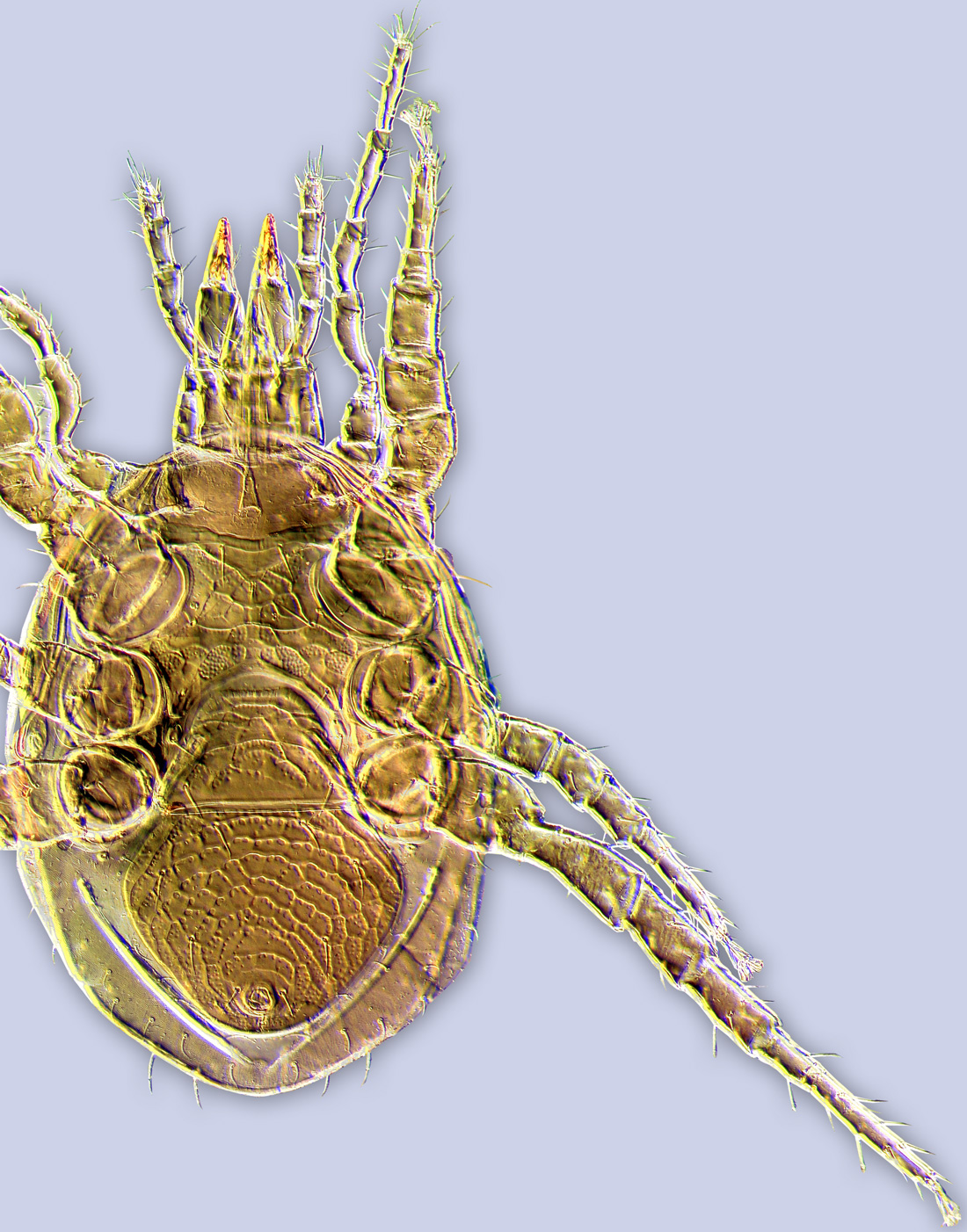Bee Mites : Acari : Parasitiformes : Mesostigmata : Macrochelidae
Genus Macrocheles Latreille, 1829
Macrocheles Latreille in Cuvier & Latreille, 1829: 282 (Type species Acarus marginatus Hermann, 1804 (=Acarus muscae domesticae Scopoli, 1772) by subsequent designation); Krantz, 1962: 146 (his synonymy).
Type speices Acarus marginatus Hermann, 1804 (=Acarus muscae domesticae Scopoli, 1772) by subsequent designation (see Notes below)
General Description. This large cosmopolitan genus includes species that inhabit a variety of habitats: soil, humus, forest litter, moss, dung, hay, rotting stumps, galleries of bark beetles and subcortical situations, nests of rodents, birds, mammals, and bumblebees. The mites are often phoretic on insects of the orders Coleoptera and Diptera. Two, apparently related, species are known from bumblebees: Macrocheles rotundiscutis Bregetova and Koroleva, 1960 (=Macrocheles bombophilus Goetz, in Hirschmann, 1970) from Europe and Macrocheles praedafimetorum Richards and Richards, 1977 from North America (see biological account on this species here). Three other species, Macrocheles muscaedomesticae (Scopoli, 1772), Macrocheles nataliae Bregetova et Koroleva, 1960, Macrocheles glaber (Müller, 1860), and Macrocheles martius (Hull, 1925), have been reported from the honey bee, Apis mellifera L. (Banaszak, 1980; Chmielewski, 1991; Haragsim et al., 1978). The two latter species are incidental inhabitants of hives, and they probably use honeybees for transport (Chmielewski, 1991). Lo and Chao (1975) reported a macrochelid mite (probably a Macrocheles) in Taiwan that occurs in the flowers of loquat (Eriobotrya japonica Lindl. (Thunb.) (Rosales: Rosaceae)) in the spring and uses both indigenous (Apis cerana Fabricius, 1793) and introduced (Apis mellifera) bee species for dispersal. The following list summarizes records of Macrocheles from bees and their nests:
Species found in association with bees
Macrocheles americanus Berlese, 1918 (as Macrocheles vagabundus) (Apis mellifera, Palaearctic (Grobov, 1974))
Macrocheles caucasicus Bregetova and Koroleva, 1960 (Apis mellifera, Palaearctic)
Macrocheles decoloratus (C.L. Koch, 1839) (Apis mellifera, Palaearctic)
Macrocheles glaber (Muller, 1860) (Apis mellifera, Holarctic, New Zealand)
Macrocheles mammifer Berlese, 1918 (nest of Melipona trinitatis in Trinidad (as Holostaspella polyornata) (Türk, 1948). New and Old World)
Macrocheles martius (Hull, 1925) (Apis mellifera, Palaearctic, New Zealand)
Macrocheles muscadomesticae (Scopoli, 1772) (Apis mellifera, Palaearctic)
Macrocheles nataliae Bregetova et Koroleva, 1960 (Apis mellifera, Palaearctic)
Macrocheles penicilliger (Berlese, 1904) (Bombus, New Zealand)
Macrocheles praedafimetorum Richards et Richards, 1977 (Bombus, Apis mellifera, Nearctic)
Macrocheles rotundiscutis Bregetova and Koroleva, 1960 (Bombus, Palaearctic)
(after Banaszak 1980, Chmielewski 1991, Crozier 1989, Grobov 1974, 1975, Haragsim et al. 1978, Homann 1933, Macfarlane 2005, Piletskaya and Zaloznaya 2004, Tomaszewska 1988; Turk, 1948)
Identification. See key here.
Notes. The type species of this genus is colloquially considered (e.g., Oudemans, 1936; Karntz, 1962; Bregetova, 1977; Evans and Till, 1979) as Acarus marginatus Hermann, 1804 (=Acarus muscae domesticae Scopoli, 1772) with the reference to Latreille in Cuvier & Latreille, 1829 (p. 282). However, in this work, two species are cited under Macrocheles Latr.: "Je rapporte à ce genre les Acarus marginatus et testudinarius d'Herman fils (Mémoire aptérol. pag 76, pl. VI fig 6, et pag 80 pl. IX fig. 1)" (p. 282). Because two species were originally placed in Macrocheles and none of them has been indicated as the type, the type designation for this genus should be attributed to the first reviewer. It is beyond the scope of our project to make a detailed investigation on this matter, but we note that Oudemans (1936, p. 169) indicated Drapiez (1841) who explicitly mentioned Acarus marginatus Hermann as the type (p. 19, "L'Acarus marginatus d'Hermann forme le type de ce genre").
References
Image Gallery
B. OConnor and P. Klimov ©
Created: April 23, 2012
Last modified: 

